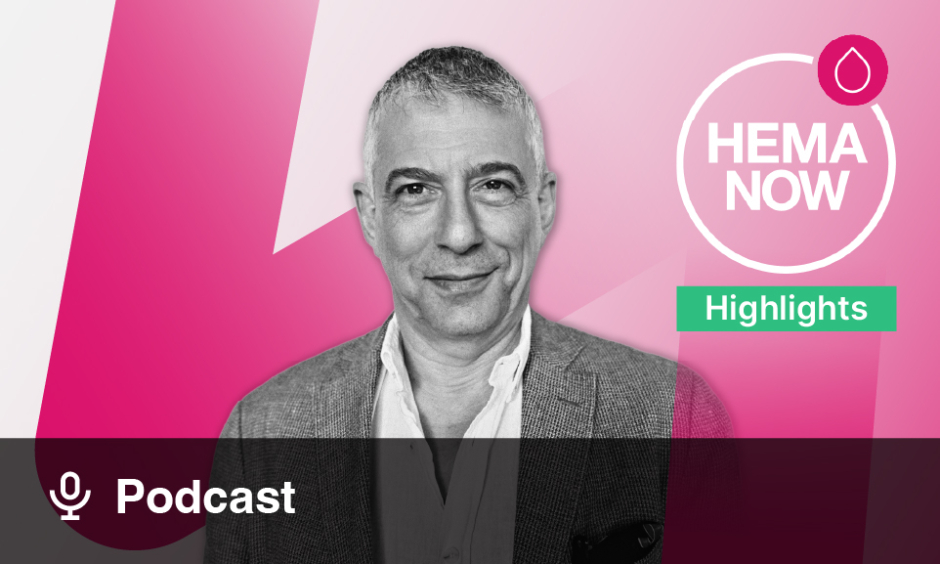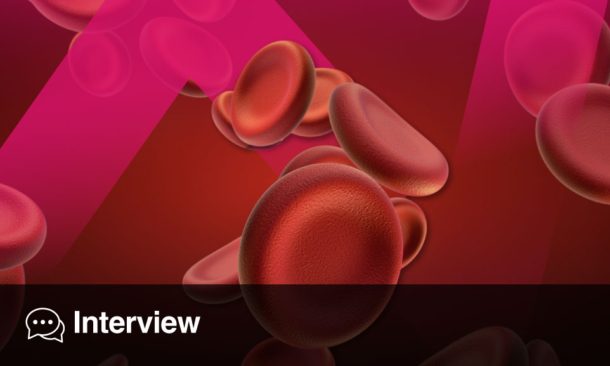THE 29th annual Congress of the European Hematology Association (EHA) took place this year in the vibrant city of Madrid, Spain, from 13th–16th June. It was a unique opportunity for haematologists from around the world to gather and discuss cutting-edge innovations in the field, advancing patient care in the process.
“Today we come together as a community of haematologists, bound by our collective commitment to advancing the field of haematology, and enhancing patient care,” announced Antonio Almeida, 2024 EHA President. He drew attention to EHA’s ambitious agenda for 2024: advancing haematology technology, personalised medicine, markers in diagnostics, equitable access to medicine, and improved sustainability. Finally, Almeida extended thanks to all the contributors of the Congress, and welcomed Brian Huntley, Chair of the EHA Scientific Committee, to the stage.
“As we gather here in Madrid, I am reminded of the profound impact that our collective efforts can have on the lives of our patients and their families,” began Huntley. He highlighted the vast quantity of sessions prepared this year (180, to be exact), and the diversity of topics covered. Additionally, over 3,500 abstract were submitted, a staggering, record-breaking figure for EHA. Continuing on, Huntley stressed EHA’s commitment to diversity, equity, and inclusion, praising the 40 countries represented in the faculty, and the introduction of their new EHA Diversity, Equity, and Inclusion award.
Winners of the EHA Research Grants were subsequently commended. For the junior research grants, aimed at supporting those starting out in their research endeavours, the winners were Lakshmi Sandhow, Institut Cochin, Paris, France; Helga Simon Molas, Amsterdam University Medical Center, the Netherlands; Femke Hormann, Karolinska Institutet, Stockholm, Sweden; Václav Šeda, CEITEC Masaryk University, Brno, Czech Republic; and Sigrún Thorsteinsdóttir, University of Iceland, Reykjavík, Iceland.
Moreover, the Advanced Research Grants, aimed at individuals 4–8 years post-PhD, were awarded to Alba Maiques-Diaz, IDIBAPS, Barcelona, Spain; Serena Scala, Ospedale San Raffaele, Milan Italy; and Mathijs Sanders, Erasmus University Medical Center, Rotterdam, the Netherlands. The Physician Scientist Research Grants were awarded to Camille Bigenwald, Institut Gustave Roussy, Villejuif, France; Simon Richardson, University of Cambridge, UK; and Delfim Duarte, Instituto de Biologia Molecular e Celular, Porto, Portugal. Enrica Federti, University of Verona, Italy, was awarded the ‘Topic-in-Focus’ Advanced Research Award.
Spotlighting global collaboration, the EHA Bilateral Collaborative Grant winners were praised and welcomed to the stage. Countries represented among the awardees included the UK, Germany, Spain, Italy, and Switzerland. Other grants additionally awarded included the 2023 and 2024 Research Mobility and Innovation grants.
Following the grant ceremony, Almeida retook the stage, focusing the audience’s attention to the José Carreras Award. Named after the famous opera singer, Carreras himself underwent a haematopoietic transplant procedure in Seattle, in 1988, and since set up the José Carreras Foundation, honouring those actively contributing to the field. The 2024 winner was John Gribben, Barts Cancer Institute, London, UK, who subsequently shared an insightful lecture on the impact of haematologic malignancies on the immune system.
“Education and mentoring are a fundamental pillar of EHA activity,” reminded Almeida, as he handed the 2024 Education and Mentoring Award to Jan Trnka, Charles University and University Hospital Motol, Prague, Czech Republic. Finally, Ivo Touw, Erasmus University Medical Center, was awarded the prestigious David Grimwade Award for his research into bone marrow failure and leukaemia predisposition syndromes, and presented an informative talk detailing the complex biology of congenital neutropenia.
Stay tuned for more insights from this incredible Congress, including late-breaking clinical trial data and an interview with the EHA President himself, Antonio Almeida.
Benefit of Isa-VRd for Transplant-Ineligible Patients with Multiple Myeloma
FIRST line treatment is crucial for patients with newly diagnosed multiple myeloma (NDMM), especially in patients who are not eligible for transplant due to age or comorbidities. The current standard of care includes a combination of bortezomib, lenalidomide, and dexamethasone (VRd).
The Phase III study, presented at EHA2024 by Thierry Facon, University of Lille and French National Academy of Medicine in Paris, France, aimed to assess the clinical benefit, efficacy, and safety of adding isatuximab (Isa), an anti-CD38 monoclonal antibody, to the VRd regimen (Isa-VRd), compared to VRd alone, in transplant-ineligible patients with NDMM.
The global IMROZ study, an open-label, global, prospective, randomised trial was conducted at 102 sites across 21 countries, with a total of 446 patients with active, measurable NDMM. The patients were randomised in a 3:2 ratio to receive either Isa-VRd or VRd. Patients over 80 years of age were excluded from the study.
The primary endpoint was progression-free survival (PFS), with key secondary endpoints being complete response rate, minimal residual disease negativity, very good partial response or better, and overall survival. Adverse events were graded according to NCI CTCAE v4.03 standards.
Results showed that, at the time of data cut-off on 26th September 2023, 265 patients received Isa-VRd, and 181 received VRd. The median treatment duration was 53.2 months for Isa-VRd compared to 31.3 months for VRd. At a median follow-up of 59.7 months, median PFS was not reached for Isa-VRd vs 54.3 months for VRd. The hazard ratio (HR) for PFS was 0.596 (98.5% CI: 0.406–0.876), indicating a significant reduction in the risk of progression or death by 40.4% with Isa-VRd. The PFS benefit was consistent across subgroups and maintained through subsequent lines of therapy and the addition of Isa did not significantly affect the relative dose intensity of VRd.
The study results demonstrate that Isa-VRd significantly reduces the risk of disease progression or death by 40.4%, compared to VRd alone, while providing deep and sustained responses. Additionally, the safety profile of Isa-VRd was consistent with the addition of Isa, and the observed numerical differences in treatment-emergent adverse events were largely due to longer exposure in the Isa-VRd arm. These results support Isa-VRd as a potential new standard of care for transplant-ineligible patients with NDMM.
APOLLO Trial: New Hope for High-Risk Acute Promyelocytic Leukaemia
HIGH-RISK acute promyelocytic leukaemia (HR-APL) is a very rare form of acute myeloid leukaemia, defined by a white blood cell count at diagnosis >10,000/µL. Only one-third of patients with APL have HR-APL, which is accompanied by a high risk of complications, including bleeding and thrombosis, especially during the first stage of treatment.
Chemotherapy combined with all trans-retinoic acid (ATRA-CHT) has become the gold standard for treatment of APL. A recent trial presented at EHA2024 assessed a new chemotherapy-free regimen of ATRA and arsenic trioxide (ATO), supplemented with two-shots of idarubicin, for treatment of patients with HR-APL compared to conventional ATRA-CHT treatment.
In the APOLLO Trial, an open-label, prospective, multicentre multinational Phase III trial, patients were randomised 1:1 to receive ATRA-ATO plus two shots of idarubicin, or ATRA-CHT. The study found that the 2-year survival rate in the ATRA-ATO group (88%; 95% CI: 80–96%) was significantly higher than in the ATRA-CHT group (70%; 95% CI: 59–83%; P=0.02). The main factors explaining the improved event-free survival were incidence of molecular relapse and molecular resistance.
The authors concluded that first-line therapy with ATRA-ATO with two initial doses of IDA results in superior event-free survival compared to conventional ATRA-CHT in patients with HR-APL, which may support implementation of this regimen as the new standard of care for patients with HR-APL.
Low-Molecular-Weight Heparin Ineffective for Preventing Thrombosis in Leukaemia
RECENT data presented at EHA2024 revealed that primary thromboprophylaxis using a fixed intermediate-dose low-molecular-weight heparin (LMWH) does not effectively prevent thrombosis in adults undergoing remission-induction treatment for acute lymphoblastic leukaemia (ALL).
Adults with ALL face a significant risk of VTE, which can lead to increased morbidity and decreased survival. This comprehensive study, a prospective side-study within the HOVON-100 trial, aimed to evaluate whether thromboprophylaxis with LMWH could mitigate this risk.
The trial included adults aged 18–70 years with newly diagnosed ALL, with patients receiving LMWH (nadroparin 5700 anti-Xa IU) from the start of their ALL treatment until Day 35 of the first remission-induction cycle (RI1). The study analysed data from 369 eligible patients, of whom 49% were aged 18–40 years, and 51% were aged 41–70 years. Patients were divided into two groups: 253 received LMWH thromboprophylaxis, while 116 did not.
The primary outcome measured was the incidence of first venous or arterial thrombosis within the first 60 days of ALL treatment. Secondary outcomes included overall thrombosis during treatment and follow-up, major bleeding events, and event-free survival.
Results indicated that 15% of patients experienced their first thrombosis within 60 days of treatment. However, LMWH did not significantly reduce this risk. Specifically, 17% of patients receiving LMWH experienced thrombosis, compared to 11% without thromboprophylaxis. The adjusted sub-distribution hazard ratio (SHR) was 1.52, indicating no significant protective effect of LMWH.
Additionally, age-dependent disparities were observed, with older patients (41–70 years)showing a higher risk when receiving LMWH (SHR: 2.47) compared to younger patients (18–40 years; SHR: 0.88).
Furthermore, no significant differences in bleeding rates were observed between the LMWH group (7%) and the non-thromboprophylaxis group (3%) during the pre-phase and RI1. Overall, 33% of patients receiving LMWH experienced thrombosis compared to 22% without thromboprophylaxis, with an adjusted SHR of 1.59. LMWH also did not impact event-free survival, with an adjusted hazard ratio of 0.82.
These findings underscore the need to re-evaluate the use of LMWH in preventing thrombosis in patients with ALL. The study concluded that thromboprophylaxis with LMWH may not only be ineffective, but potentially disadvantageous for older patients, especially those not receiving PEG-asparaginase in RI1, calling for randomised trials to confirm these results and guide future treatment protocols.
Novel CAR-T Cell Therapy for Myelofibrosis
A NOVEL chimeric antigen receptor (CAR)-T cell therapy has been developed to treat myelofibrosis by targeting calreticulin mutant neoplasms, according to findings presented at EHA2024.
Currently, the median survival time for myelofibrosis is 5 years, and the only curative treatment option available is allogeneic stem cell transplantation, which is highly toxic (with a 25% treatment-related mortality) and only available to 10–20% of patients. CAR-T cell therapy offers a new curative treatment option, as CAR-T cells specifically target malignant stem cells, and restore normal haematopoiesis.
To develop the novel CAR-T cell therapy, researchers first identified a binder that selectively binds to mutated calreticulin, and incorporated it into a CAR-T structure. The function and persistence of the CAR-T cells were analysed with repeated stimulation from calreticulin-mutated cancer cells.
Efficacy of treatment was tested in patient samples in vitro, and then in vivo using mouse models. In vitro, there was a 60–70% elimination of malignant cells, with no off-target toxicity against JAK2-mutated stem cells, and there was no unexpected toxicity in the mouse models.
The pre-clinical results show that this novel CAR-T cell therapy can selectively target calreticulin mutant neoplasms, without toxicity, highlighting its potential as a new curative treatment option to induce long-lasting remission in patients with myelofibrosis. The researchers are continuing to develop the therapy, including identifying a suitable lymphodepleting strategy, and plan to conduct a clinical trial in humans in the future.
New Treatment Regimen for Hodgkin’s Lymphoma
The BEACOPP regimen, while highly effective and offering impressive progression-free survival rates, has raised concerns due to its intense short- and long-term side effects, prompting questions about its risk-to-benefit ratio. Globally, many physicians opt for the chemotherapy drug combination ABVD, including doxorubicin, bleomycin, vinblastine, and dacarbazine; which is less intensive but also less effective.
In response to these concerns, the German Hodgkin Study Group developed a strategy that adapts to the individual risk of patients using interim PET scans. Patients showing a strong response to treatment after four cycles continue with just four cycles, while those not responding as well receive six cycles. In the HD21 study, researchers aimed to improve the regimen by significantly reducing its duration and intensity. The traditional BEACOPP regimen, which involved 2-week cycles and 8-day infusions, was modified with brentuximab vedotin, an antibody-drug conjugate with an improved risk-benefit profile, to create a more manageable 3-day regimen.
The HD21 study enrolled 1,500 patients from nine countries, including those in Western Europe, Australia, and New Zealand.
This investigator-initiated trial addressed two primary questions: improving tolerability and maintaining efficacy. The new BrECADD regimen showed significantly reduced treatment-related morbidity compared to BEACOPP, with fewer transfusions and lower incidences of neuropathy. Notably, the recovery of gonadal function in females and males was significantly better.
Regarding efficacy, BrECADD exceeded expectations. Unlike ABVD, which has a more tolerable toxicity profile, BrECADD maintained high efficacy rates. The study achieved better outcomes than expected, with two-thirds of patients completing treatment within 12 weeks, and a 4-year progression-free survival rate of 97%, a remarkable result in clinical trials.
The research team concluded by highlighting that the novel BrECADD regimen is not only better tolerated, but also more effective. It significantly reduces treatment duration and toxicity while achieving unprecedented progression-free survival rates. The risk-to-benefit ratio is highly favourable, making it a recommended treatment approach for patients with Hodgkin’s lymphoma.
Glofitamab-GemOx Therapy Significantly Improves Outcome in Relapsed Lymphoma
RESEARCHERS presented a promising new combination therapy for patients with relapsed or refractory diffuse large B-cell lymphoma (DLBCL). Glofitamab (Glofit), a CD20 bispecific antibody, had previously shown durable responses as a monotherapy for DLBCL.
The STARGLO trial aimed to evaluate the efficacy and safety of Glofit in combination with GemOx compared to the conventional Rituximab-GemOx regimen. Findings from the global Phase III STARGLO were presented in a plenary abstract at EHA2024.
The study enrolled 274 patients who had undergone at least one prior line of therapy. Participants were randomly assigned to receive either Glofit-GemOx or Rituximab-GemOx, with the study population stratified by the number of prior therapies and refractoriness to the last treatment. The trial comprised adults aged 18–70 years, with many participants ineligible for autologous stem cell transplant due to age, organ dysfunction, or other comorbidities. In the study, patients received eight cycles of their assigned combination therapy. Those in the Glofit-GemOx group continued with four additional cycles of glofitamab monotherapy. The primary endpoint was overall survival (OS), while secondary endpoints included progression-free survival (PFS) and complete remission rates, assessed by an independent review committee.
At the primary analysis cut-off date of 29th March 2023, Glofit-GemOx demonstrated a significant OS benefit with a hazard ratio of 0.59. With a median follow-up of 11.3 months, the median OS for the Glofit-GemOx group was not reached, while it was 9 months for the Rituximab-GemOx group. The Glofit-GemOx group also showed a marked improvement in PFS with a hazard ratio of 0.37 and a significantly higher complete remission rate (50.3%) compared to the Rituximab-GemOx group (22.0%).
A follow-up analysis with a median follow-up of 20.7 months reinforced these findings, showing continued superiority of Glofit-GemOx in median OS (25.5 versus 12.9 months) and PFS (13.8 versus 3.6 months). Adverse event rates were higher in the Glofit-GemOx group, including serious adverse events such as cytokine release syndrome. However, when adjusted for exposure differences, the rates were comparable between the groups.
The study authors concluded that Glofit-GemOx offers a statistically significant and clinically meaningful improvement in survival outcomes for patients with relapsed/refractory DLBCL who are ineligible for autologous stem cell transplant.
Vitamin C Supplementation for Clonal Cytopenia or Low-Risk Myeloid Malignancies
STINE Ulrik Mikkelsen, Biotech Research and Innovation Centre, University of Copenhagen, Denmark, presented novel data at EHA2024 regarding vitamin C supplementation in patients with low-risk myeloid malignancies and the precursor condition clonal cytopenia of undetermined significance (CCUS).
The purpose of the EVI-2 study was to investigate if oral vitamin C supplementation was safe and could alter disease characteristics and health outcomes in patients with low-risk myeloid malignancies (low-risk myelodysplastic syndromes and myeloproliferative neoplasms) and CCUS. The study was an international, multicentre, randomised, placebo-controlled, double-blind Phase II study that enrolled 109 patients from four sites in Denmark and the USA. Patients were randomised 1:1 to receive oral vitamin C 1,000 mg (n=55) or placebo (n=54) every day for 12 months. The primary study endpoint was change in mean allele variant frequency (clone size), and key secondary endpoint was vitamin C plasma concentration, safety, and overall survival.
Results showed that vitamin C deficiency was effectively overcome in all patients in the vitamin C group. Notably, a significant improvement in overall survival was observed in patients taking vitamin C supplements compared to the placebo group. The preliminary primary endpoint showed that clone size did not differ between treatment groups.
As the first study to report on vitamin C supplementation in patients with low-risk myeloid cancers and CCUS, it is a significant step forward in understanding this association. Mikelsen stressed that additional larger studies will be required to fully understand the effect of oral vitamin C in patients with low-risk myeloid cancers.






